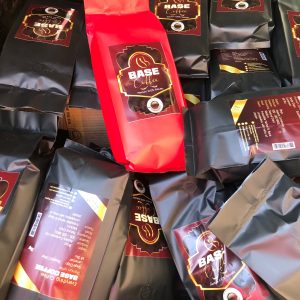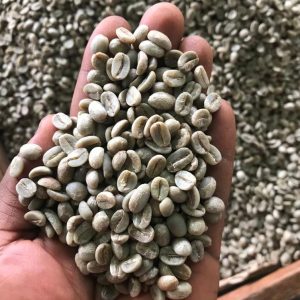Robusta coffee, scientifically known as Coffea canephora, possesses several distinct characteristics that set it apart from its more famous counterpart, Arabica coffee. Some of the most notable attributes of Robusta coffee include:
- Flavor and aroma: Robusta coffee is known for its strong, bold, and bitter taste, often described as earthy, woody, or even rubbery. Its unique aroma is characterized by a mix of earthy and nutty notes, contributing to its robust profile.
- Caffeine content: One of the defining features of Robusta coffee is its high caffeine content, nearly double that of Arabica coffee. The increased caffeine levels contribute to its more robust flavor and provide natural pest resistance, making it easier for farmers to cultivate.
- Bean size and shape: Robusta coffee beans are generally smaller and rounder than Arabica beans, with a straight crease down the middle. The more compact shape results from the differences in the plant species and the growing conditions required for Robusta coffee.
- Bean composition: Robusta coffee beans have a thicker outer layer than Arabica beans, which helps protect the beans during the harvesting and processing stages. This thicker outer layer also contributes to the overall hardiness of Robusta coffee plants, making them more resistant to pests and diseases.
- Growing conditions: Robusta coffee plants are better adapted to lower elevations and warmer climates than Arabica coffee. This adaptability allows Robusta to be cultivated in a broader range of environments, particularly in countries located in Africa and Southeast Asia, where it has become a significant cash crop.
In conclusion, Robusta coffee is distinguished by its strong, bitter flavor, unique aroma, high caffeine content, bean size and shape, and adaptability to various growing conditions. These characteristics have contributed to its popularity in blends, instant coffee, and espresso drinks, making Robusta coffee an essential part of the global coffee market.
Growing Conditions for Robusta Coffee
Robusta coffee, scientifically known as Coffea canephora, thrives in specific growing conditions that differentiate it from Arabica coffee. Some of the essential factors that influence Robusta coffee cultivation include:
- Climate: Robusta coffee trees require warm, humid weather with temperatures ranging between 22°C to 30°C (72°F to 86°F). These plants are better adapted to heat than Arabica coffee, making them suitable for cultivation in tropical and subtropical regions.
- Altitude: Robusta coffee grows best at lower elevations, typically between 200 and 800 meters above sea level. This contrasts with Arabica coffee, which flourishes at higher altitudes of 900 to 2,000 meters. The lower elevation requirement enables Robusta coffee to be cultivated in various environments.
- Rainfall: Robusta coffee plants need plenty of rain, usually 1,500 to 3,000 millimeters yearly. Adequate and well-distributed rainfall throughout the year is crucial for healthy growth, as it helps maintain soil moisture and promote the development of coffee cherries.
- Soil: Robusta coffee plants can tolerate various soil types but perform best in well-drained, fertile soils with a pH range of 5.5 to 7.0. Proper soil management practices, including organic matter and erosion control measures, are essential for maintaining soil health and productivity.
- Tree size: Robusta coffee trees can grow up to 10 meters tall in their natural state, but they are typically pruned to a height of 2 to 3 meters to facilitate easier harvesting and improve yield. Pruning also helps maintain the tree’s overall health and vigor, ensuring a more consistent coffee bean production.
In summary, Robusta coffee thrives in warm, humid climates with abundant rainfall and lower elevations. It can adapt to various soil types and requires proper pruning practices for optimal growth and yield. These growing conditions contribute to the hardiness of Robusta coffee plants and their widespread cultivation in tropical and subtropical regions across the globe.
Harvesting Robusta Coffee
Harvesting Robusta coffee is an essential step in the coffee production process, and it plays a significant role in determining the quality of the final product. Here is an overview of the Robusta coffee harvesting process:
- Harvesting method: Robusta coffee is typically harvested by hand, mainly due to the height of the trees and the need to pick only the ripe cherries. In some cases, growers may use long-handled tools to reach higher branches, but manual picking remains the preferred method for ensuring optimal cherry selection.
- Cherry ripeness: The Robusta coffee cherries are harvested when fully ripe, usually 9 to 11 months after flowering. Ripe cherries will be deep red and firm to the touch. Picking the cherries at the right stage of ripeness is crucial for producing high-quality coffee beans, as underripe or overripe cherries can negatively impact the taste and aroma.
- Harvesting season: The specific timing of the Robusta coffee harvesting season varies depending on the location and local climate conditions. However, the general harvest season for Robusta coffee falls between October and February. Some regions with a bimodal rainfall pattern may have two distinct harvest seasons within a year.
- Selective picking: During harvesting, workers pick only the ripe cherries, leaving the unripe ones on the tree to mature. This particular picking method helps maintain the quality of the harvested beans and allows the remaining cherries to reach full ripeness before they are harvested in subsequent rounds.
- Post-harvest processing: After the cherries are harvested, they undergo post-harvest processing, which involves removing the outer fruit layer, fermenting and washing the beans, and drying them to reduce moisture content. Proper post-harvest processing is essential for preserving the beans’ quality and preventing spoilage.
In conclusion, Robusta coffee harvesting involves the manual picking of ripe cherries, with the harvest season generally occurring between October and February. Careful selection of cherries and proper post-harvest processing are critical factors in ensuring the quality of the final coffee product.
Processing Robusta Coffee
Processing Robusta coffee is crucial in transforming harvested cherries into green coffee beans ready for roasting. The two primary methods used for processing Robusta coffee are dry and wet. Each method has advantages and drawbacks, and the choice depends on factors such as local conditions, available resources, and desired coffee characteristics.
- Dry Processing: Also known as the natural or unwashed method, dry processing involves spreading the harvested cherries in thin layers under the sun to dry. This process can take several weeks, during which the cherries are regularly turned and raked to ensure even drying. Once the cherries reach a moisture content of around 11%, they are hulled to remove the dried fruit layer, leaving the green coffee beans behind. Dry processing typically results in a coffee with a fuller body and lower acidity compared to wet-processed coffee.
Advantages of dry processing:
- Lower water usage, making it suitable for areas with limited water resources.
- Simpler infrastructure requirements.
- Produces coffee with unique flavors and characteristics.
Drawbacks of dry processing:
- Requires a significant amount of space for drying cherries.
- Dependent on favorable weather conditions.
- This can result in inconsistent quality due to varying drying conditions.
- Wet Processing: Also known as the washed method, wet processing starts by removing the outer fruit layer through a pulper machine. The remaining beans, still covered in mucilage, are then fermented in water for 12 to 48 hours to break down the mucilage layer. After fermentation, the beans are washed and dried in the sun or mechanical dryers until they reach the desired moisture content of around 11%. Finally, the beans are hulled to remove any remaining parchment layer.
Advantages of wet processing:
- Produces coffee with a cleaner, brighter flavor and higher acidity.
- Allows for better quality control and consistency.
- Reduces the risk of defects associated with improper drying.
Drawbacks of wet processing:
- It requires a significant amount of water, making it less suitable for areas with water scarcity.
- More complex infrastructure requirements.
- Higher production costs compared to dry processing.
In summary, processing Robusta coffee involves either dry or wet methods, each with its advantages and drawbacks. The processing method choice depends on local conditions, resources, and desired coffee characteristics. Proper processing is essential for ensuring the quality and consistency of the final coffee product.







Reviews
There are no reviews yet.